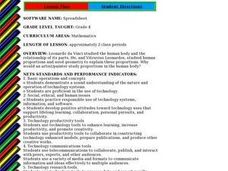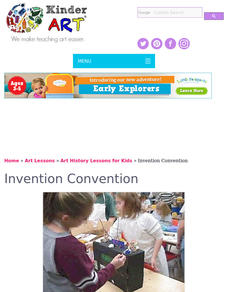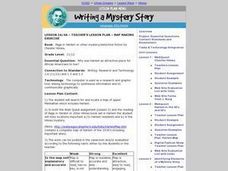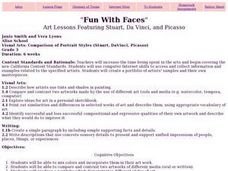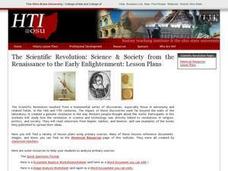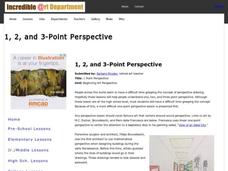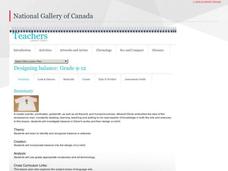Curated OER
Parachutes
Students examine how parachutes work, and research and discuss the first man to envision and sketch the first parachute. They analyze air resistance, drag force, drop time, and terminal velocity.
Curated OER
WebQuest on 1940/1950 Harlem
Students perform a WebQuest to fin out why Harlem was an attractive place for African Americans to live. Small groups perform the research together, and report to the class.
Curated OER
Body Proportion
Fourth graders measure the height and arm span of various classmates. They use a spreadsheet to design a graph that shows the class measurements from tallest to shortest in metric and standard systems.
Curated OER
The Codex Comes Home: Leonardo Lives in Seattle
Students complete a unit on the life of Leonardo da Vinci and the content of the Codex Leicester. They write an encyclopedia entry, watch a film, complete a data sheet, conduct Internet research, and write a letter to Bill Gates about...
Curated OER
What a Square
Students examine the painting "Old Man With A Gold Chain" by Rembrandt. They identify geometric shapes in the painting, measure these shapes and compare the relationships of these measurements.
Curated OER
Invention Convention
Fifth graders recognize the work of Leonardo da Vinci. They invent a new machine for the 21st century and make a model of the invention.
Curated OER
Map Making Exercise
Students complete a Web Quest in order to determine why Harlem was an attractive place for African Americans to live. They study a map of Harlem in the 1930's.
Curated OER
Romare Bearden and the Face Collage
Fourth graders create a collage from magazines and newspapers to create a face. After finishing the face, they use mixed media to complete the background. They write their own description and examine the life and works of Romare Beardon.
Curated OER
Fun With Faces: Stuart, Da Vinci and Picasso
Third graders conduct research and review art work to compare the styles of Stuart, Da Vinci and Picasso. They develop and compile a portfolio including masterpieces of these artists and original works. Students compose detailed...
Curated OER
What's Right and Wrong? Moral Messages in Art
Students explore the Steen and Mount paintings and their presentation of moral issues. They discuss ethical debates in society today and write a short position paper on an issue raised by the paintings or in the discussion. They make a...
Curated OER
Not Everyone Lived in Castles During the Middle Ages
Students complete a variety of online activities surrounding their study of the Middle Ages. They focus on the various levels of the class sytem and then role play a member of a given class.
Curated OER
Analyzing the Use of Irony in a Short Story
Ninth graders examine how literature connects to real-life and see how irony aids in the development of theme. They read Shirley Jackson's The Lottery, and discuss elements of foreshadowing and situational irony. Then learners will write...
Curated OER
Creating Relief Sculpture
High schoolers design and create a sculptural relief using modeling clay.They create latex rubber molds and then produce relief sculptures using Sculptamold.
Curated OER
The Scientific Revolution
Scientists participate in studying how new scientific advances have changed the world. They explain how astronomers have changed the way people view the universe, summarize the advances that were made in chemistry and medicine, and...
Curated OER
Compare and Contrast Timelines of the World
Seventh graders create a classroom timeline of important world events. This lesson is meant to be used during the entire school year. As the school year goes along, events are added to the timeline as chosen by the class. The events are...
Curated OER
What Makes the Writer Write
Your 11th and 12th graders are ready to critique society! Channel that inclination by studying a novel that offers social criticism of other eras (book recommendations included). This resource presents a well-thought-out overview of such...
Roy Rosenzweig Center for History and New Media
War and Poetry
A band of brothers or the Devil's agents? Nobel warriors freeing the oppressed or mercenaries working for the military/industrial complex? Groups examine poems from the Civil War, World War I, and World War II to determine the poets'...
National Gallery of Canada
Reading Symbols
Introduce your upper-elementary students to printmaking. Class members view prints, select and research symbols in a piece, and create their own sets of prints using styrofoam trays. Pupils can wash off the paint on their trays to make...
National Gallery of Canada
My First Print
Practice printmaking with a fun activity. After observing images, class members use the listed materials, such as stamps and sponges, create their own prints. They experiment with layering, pressure, and paint colors.
National Gallery of Canada
Mastering One-Point Perspective
Cover one-point perspective through observation and practice. Class members examine several works of art that use one-point perspective, look at magazine images to find the vanishing points and horizon lines, and draw their own city...
Incredible Art
1, 2, and 3-Point Perspective
Introduce drawing students to perspective with a series of lesson that detail how to draft images in one-, two-, and three-point perspective. Each exercise includes step-by-step, illustrated directions and examples.
National Gallery of Canada
Designing Balance
Teach your artists how to incorporate balance into their work through discussion and action. After viewing and discussing several works of art, learners design a balanced image for a T-shirt and follow the step-by-step instructions to...
National Gallery of Canada
Emphasizing Prints
Focus on how an artist creates emphasis on certain areas of a work with an examination of several works of art and a printmaking project. Follow the discussion suggestions and step-by-step printmaking instructions to successfully...
EngageNY
Why Do Banks Pay YOU to Provide Their Services?
How does a bank make money? That is the question at the based of a lesson that explores the methods banks use to calculate interest. Groups compare the linear simple interest pattern with the exponential compound interest pattern.
Other popular searches
- Harlem Renaissance
- Renaissance Inventions
- Renaissance Art
- Renaissance Harlem American
- Art and Music Renaissance
- Italian Renaissance
- Renaissance Man
- Renaissance Paintings
- Renaissance Lessons
- Renaissance Music
- The Renaissance
- Renaissance Food




